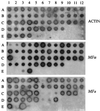Origin of Cryptococcus neoformans var. neoformans diploid strains
- PMID: 11682503
- PMCID: PMC88460
- DOI: 10.1128/JCM.39.11.3889-3894.2001
Origin of Cryptococcus neoformans var. neoformans diploid strains
Abstract
The basidiomycetous yeast Cryptococcus neoformans is an important human fungal pathogen. Two varieties, C. neoformans var. neoformans and C. neoformans var. gattii, have been identified. Both are heterothallic with two mating types, MATa and MATalpha. Some rare isolates are self-fertile and are considered occasional diploid or aneuploid strains. In the present study, 133 isolates, mostly from Italian patients, were investigated to detect the presence of diploid strains in the Igiene Università Milano culture collection. All of the diploid isolates were further investigated by different methods to elucidate their origins. Forty-nine diploid strains were identified by flow cytometry. PCR fingerprinting using the (GACA)(4) primer showed that the diploid state was associated with two specific genotypes identified as VN3 and VN4. Determination of mating type on V8 juice medium confirmed that the majority of the strains were sterile. PCR and dot blotting using the two pheromone genes (MFa and MFalpha) as probes identified 36 of the 49 diploid isolates as MATa/alpha. The results of pheromone gene sequencing showed that two allelic MFalpha genes exist and are distinct for serotypes A and D. In contrast, the MFa gene sequence was conserved in both serotype alleles. Amplification of serotype-specific STE20 alleles demonstrated that the diploid strains contained one mating locus inherited from a serotype A parent and one inherited from a serotype D parent. The present results suggest that diploid isolates may be common among the C. neoformans population and that in Italy and other European countries serotype A and D populations are not genetically isolated but are able to recombine by sexual reproduction.
Figures



References
-
- Chaturvedi S, Rodeghier B, Fan J, McClelland C M, Wickes B L, Chaturvedi V. Direct PCR of Cryptococcus neoformans MATα and MATa pheromones to determine mating type, ploidy, and variety: a tool for epidemiological and molecular pathogenesis studies. J Clin Microbiol. 2000;38:2007–2009. - PMC - PubMed
-
- Cogliati M, Allaria M, Liberi G, Tortorano A M, Viviani M A. Sequence analysis and ploidy determination of Cryptococcus neoformans var. neoformans. J Mycol Med. 2000;10:171–176.

